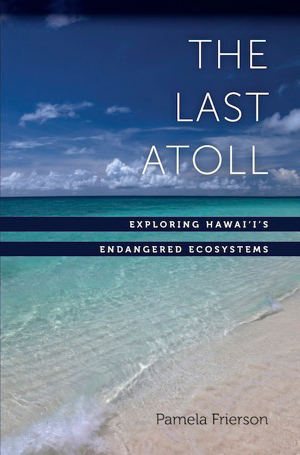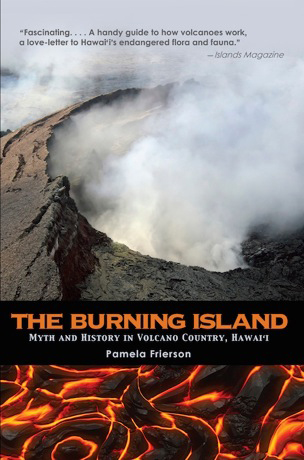words
Books
 Far from the beach-towel -covered sands of Waikiki there is a hidden Hawai`i: remote islands and atolls that are some of the wildest—and at the same time most vulnerable—places on earth. Little has been written about them…until now.
Far from the beach-towel -covered sands of Waikiki there is a hidden Hawai`i: remote islands and atolls that are some of the wildest—and at the same time most vulnerable—places on earth. Little has been written about them…until now.
In The Last Atoll, Pamela Frierson chronicles a decade of travels deep into the Northern Pacific to an older, richer, and strangely neglected part of the Hawaiian archipelago. The Northwestern islands and their one hundred thousand – plus square miles of coral reefs are home to some of the world’s rarest species, including the Hawaiian monk seal, the Laysan duck, and the Nihoa millerbird. The reefs, still largely unexplored, are one of the last intact Pacific ecosystems, dominated by the big marine predators: giant jacks, groupers and sharks.
But according to Pamela Frierson this far-flung region of Hawai`i is “both pristine and plundered.” In a series of often arduous journeys she uncovers a history of use and abuse. At Midway Atoll she watches the politics of clean-up as a Naval Facility shuts down, and learns about clandestine Cold War activities; at Laysan Island she chronicles a legacy of guano mining and bird feather hunting that led to the extinction of three out of five endemic land birds. Among one of the richest wildlife aggregations on the planet, at French Frigate Shoals, she explores islands as places of the imagination and as “canaries in a cage” in a changing world.
“It’s wonderful to have another book from Pamela Frierson about her beloved Hawai`i—this time about its farthest Northwestern atolls—fragile, contaminated, and plundered worlds unchronicled and previously ignored in our letters. She lives among its monk seals, short-tailed albatrosses, petrels, and Laysan ducks, hopping island to atoll, lagoon to fringing reef over the course of ten years of patient exploration and research. From this, an inspiring personal odyssey, she brings us a book in the ecological tradition of Rachel Carson’s Silent Spring that is also like a piece of extended war reportáge—for these islands were once indeed a combat zone and its dear creatures victims of our cold and riotous pillage. Homage to Ms. Frierson and homage to this living, precious world she brings to us.”
Garrett Hongo, author of Coral Road“As with her previous book, The Burning Island, Pamela Frierson again takes readers to one of the most remote and ecologically fragile places on the planet. Gracefully written in the tradition of Rachel Carson, The Last Atoll is a personal trek to a chain of tiny, northwest Hawaiian islands, where Frierson brings us nose-to-nose with endangered Hawaiian monk seals, coral polyps, green sea turtles, and golden gooneys—alongside the fossils of long-extinct species, the bones of animals on the edge of vanishing, and the ravages of guano mining, coral dredging, and military bases. The Last Atoll skillfully travels through myth, culture, and history, and arrives at present-day attempts to preserve islands that are as biologically significant as the Galápagos.”
Frank Stewart, editor of Manoa“The Last Atoll draws a vivid portrait of what might just be my favorite place on Earth (and that’s saying something), the secret islands Northwest of Hawaii. It’s a place that still feels like the original world, like Earth before us. There the nations are of seabirds, the world is almost entirely ocean, and the air roars with the calls of them in their millions. It feels like Life at full burn. But as Pamela Frierson’s work shows, there is much more, even, than first greets the eye.”
Carl Safina, author of The View from Lazy Point
 and a new edition of The Burning Island —
and a new edition of The Burning Island —
Westerners–from early missionaries to explorers to present-day artists, scientists, and tourists–have always found volcanoes fascinating and disturbing. Native Hawaiians, in contrast, revere volcanoes as a source of spiritual energy and see the volcano goddess Pele as part of the natural cycle of a continuously procreative cosmos. Volcanoes hold a special place in our curiosity about nature.
The Burning Island is an intimate, multilayered portrait of the Hawaiian volcano region—a land marked by a precarious tension between the harsh reality of constant geologic change, respect for mythological traditions, and the pressures of economic exploitation. Pamela Frierson treks up Mauna Loa, the world’s largest active volcano, and Kilauea to explore how volcanos work, as well as how their powerful and destructive forces reshape land, cultures, and history. Her adventures reveal surprising archeological ruins, threatened rainforest ecosystems, and questionable real estate development of the islands. Now a classic of nature writing, Frierson’s narrative sets the stage for a larger exploration of our need to take great care in respecting and preserving nature and tradition while balancing our ever-expanding sense of discovery and use of the land.
“The subtitle of The Burning Island bills it as a “journey through myth and history in the volcano country….” It is that, and more. The book is also a handy guide to how volcanoes work, a love letter to Hawai`i’s endangered flora and fauna, and an exposé of the short-sighted greed of developers and small-time politicians. The Burning Island is as fascinating as the Big Island itself. And that’s saying a lot”
Islands Magazine“Frierson, formerly with The Hawai’I Observer, combines cultural and natural history with a compelling personal narrative…. Highly recommended for general and Hawaiiana collections, and useful for travel collections too.”
Starred review, Library Journal“…[The Burning Island is] an ambitious and complex book, beautifully written and thoroughly researched…. Frierson’s writing reminds us to what extent the modern human is severed from a relationship with the land. The Burning Island is as much a book for local readers as for those outside Hawai’I because it presents a reinterpretation of the place of the volcano in Hawaiian history, and for those of us who live here, a new means back into the sacredness of the land. For that reason, Frierson’s book is nature writing at its best.”
Manoa Journal“…an extraordinary book….Frierson has tackled one of the most profund issues in Hawai`i.”
Honolulu Star Bulletin“Frierson is brilliant on the subject of volcanoes.”
San Francisco Chronicle
Order from your favorite local bookseller, or from: amazon | powells | barnes and noble
Selected list of published articles and essays
“Midway Not Just For the Birds,” Los Angeles Times, March 18, 2007.
“The Changing Face of Kokee,” Hana Hou, February 2006.
“Plucky Ducks,” Wildlife Conservation, January 2006.
Several mini essays in: Barry Lopez, ed., Home Ground: Language for an American Landscape, Trinity University Press 2006.
“Life from Lava,” Nature Conservancy, Summer 2003.
“Protecting the Northwestern Hawaiian Islands,” Honolulu Weekly, September 3, 2002.
“How Paradise Lost a Radical Public-Private Venture,” Christian Science Monitor, June 26, 2002.
“Veins of the Volcano,” Hana Hou, October, 2001.
“Counting Big Birds,” Wildlife Conservation, July 2001.
“The Unadulterated Aloha Tour,” Whole Earth, Fall, 2000.
“Darwinian Delights,” Hana Hou (Hawaiian Air Magazine), October, 2000.
“Fear in the Shape of a Fish,” essay written for Intimate Nature: The Bond Between Women and Animals, Ballantine, 1998.
“Going, Going Gone, to the Goonies,” Christian Science Monitor, April 16, 1997.
“Bunking with Albatross,” Wildlife Conservation, March, 1997.
“Visions of Paradise,” essay written for Discovery: The Hawaiian Odyssey, Bishop Museum Press, 1993.
“Sacred Darkness,” excerpt from The Burning Island. In John Murray, ed,; A Thousand Leagues of Blue, Sierra Club Books, 1993.
“The Rise of Nature Writing: America’s Next Great Genre?” Manoa Literary Journal, Fall, 1992.